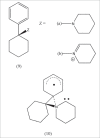Clinical physiology and mechanism of dizocilpine (MK-801): electron transfer, radicals, redox metabolites and bioactivity
- PMID: 20716924
- PMCID: PMC2835885
- DOI: 10.4161/oxim.3.1.10028
Clinical physiology and mechanism of dizocilpine (MK-801): electron transfer, radicals, redox metabolites and bioactivity
Abstract
Dizocilpine (MK-801), an extensively investigated drug possessing secondary amine and benzenoid functions, displays a wide array of biological properties, including anticonvulsant and anesthetic. There is scant discussion of biomechanism. A relevant, important finding is formation of oxidative metabolites in the hydroxylamine and phenolic categories. Analogy to cocaine metabolites suggests participation of redox entities, such as, hydroxylamine, nitroxide and nitrosonium, which can lead to electron transfer and radical formation. There is also similarity to metabolism by 3,3'-iminodipropionitrile and phencyclidine. Alternatively, the phenolic metabolites are well-known precursors of ET quinones. The review documents various physiological effects, mainly involving the central nervous system. Also of interest are the pro- and ant-oxidant properties. Considerable attention has been paid to MK-801 as an antagonist of the N-methyl-D-aspartate receptor in the glutamate category. This aspect is often associated with effects on the central nervous system. The review also provides recent literature dealing with MK-801/NMDA receptor in various areas of bioactivity. Studies were made of MK-801 involvement in working memory processing. Deficits in behavior were noted after administration of the drug. Treatment of mice with dizocilpine induced learning impairment. The influence of MK-801 on fear has been investigated. The substance is known to exert an analgesic effect in pain control. A number of reports deal with anesthetic properties.
Figures



Similar articles
-
Role of oxidative metabolites of cocaine in toxicity and addiction: oxidative stress and electron transfer.Med Hypotheses. 2005;64(2):350-6. doi: 10.1016/j.mehy.2004.06.028. Med Hypotheses. 2005. PMID: 15607570
-
Chronic treatment with caffeine blunts the hyperlocomotor but not cognitive effects of the N-methyl-D-aspartate receptor antagonist MK-801 in mice.Psychopharmacology (Berl). 2003 Mar;166(3):258-63. doi: 10.1007/s00213-002-1362-1. Epub 2003 Feb 13. Psychopharmacology (Berl). 2003. PMID: 12589526
-
Arcaine and MK-801 make recall state-dependent in rats.Psychopharmacology (Berl). 2008 Dec;201(3):405-11. doi: 10.1007/s00213-008-1304-7. Epub 2008 Aug 30. Psychopharmacology (Berl). 2008. PMID: 18758754
-
Differential effects of histamine H(3) receptor inverse agonist thioperamide, given alone or in combination with the N-methyl-d-aspartate receptor antagonist dizocilpine, on reconsolidation and consolidation of a contextual fear memory in mice.Neuroscience. 2011 Oct 13;193:132-42. doi: 10.1016/j.neuroscience.2011.07.034. Epub 2011 Jul 28. Neuroscience. 2011. PMID: 21802497
-
Evidence for the participation of glutamate in reflexes involving afferent, substance P-containing nerve fibres in the rat.Br J Pharmacol. 1996 Jan;117(1):71-8. doi: 10.1111/j.1476-5381.1996.tb15156.x. Br J Pharmacol. 1996. PMID: 8825345 Free PMC article.
Cited by
-
NMDA Receptors and Oxidative Stress Induced by the Major Metabolites Accumulating in HMG Lyase Deficiency Mediate Hypophosphorylation of Cytoskeletal Proteins in Brain From Adolescent Rats: Potential Mechanisms Contributing to the Neuropathology of This Disease.Neurotox Res. 2015 Oct;28(3):239-52. doi: 10.1007/s12640-015-9542-z. Epub 2015 Jul 15. Neurotox Res. 2015. PMID: 26174040
-
Selective blockade of N-methyl-D-aspartate channels in combination with dopamine receptor antagonism induces loss of the righting reflex in mice, but not immobility.Psychopharmacology (Berl). 2015 Jan;232(1):39-46. doi: 10.1007/s00213-014-3634-y. Epub 2014 May 31. Psychopharmacology (Berl). 2015. PMID: 24879496
-
N-methyl-D-aspartate receptor hypofunction as a potential contributor to the progression and manifestation of many neurological disorders.Front Mol Neurosci. 2023 Jun 15;16:1174738. doi: 10.3389/fnmol.2023.1174738. eCollection 2023. Front Mol Neurosci. 2023. PMID: 37396784 Free PMC article. Review.
-
NMDA Receptor and Its Emerging Role in Cancer.Int J Mol Sci. 2023 Jan 28;24(3):2540. doi: 10.3390/ijms24032540. Int J Mol Sci. 2023. PMID: 36768862 Free PMC article. Review.
-
Bidentatide, a Novel Plant Peptide Derived from Achyranthes bidentata Blume: Isolation, Characterization, and Neuroprotection through Inhibition of NR2B-Containing NMDA Receptors.Int J Mol Sci. 2021 Jul 26;22(15):7977. doi: 10.3390/ijms22157977. Int J Mol Sci. 2021. PMID: 34360755 Free PMC article.
References
-
- Kovacic P, Becvar LE. Mode of action of anti-infective agents: emphasis on oxidative stress and electron transfer. Curr Pharm Des. 2000;6:143–167. - PubMed
-
- Kovacic P, Osuna JA. Mechanisms of anticancer agents: emphasis on oxidative stress and electron transfer. Curr Pharm Des. 2000;6:277–309. - PubMed
-
- Kovacic P, Jacintho JD. Mechanism of carcinogenesis: focus on oxidative stress and electron transfer. Curr Med Chem. 2001;8:773–796. - PubMed
-
- Kovacic P, Jacintho JD. Reproductive toxins: pervasive theme of oxidative stress and electron transfer. Curr Med Chem. 2001;8:863–892. - PubMed
-
- Kovacic P, Sacman A, Wu-Weis M. Nephrotoxins: widespread role of oxidative stress and electron transfer. Curr Med Chem. 2002;9:823–847. - PubMed
Publication types
MeSH terms
Substances
LinkOut - more resources
Full Text Sources
Other Literature Sources

